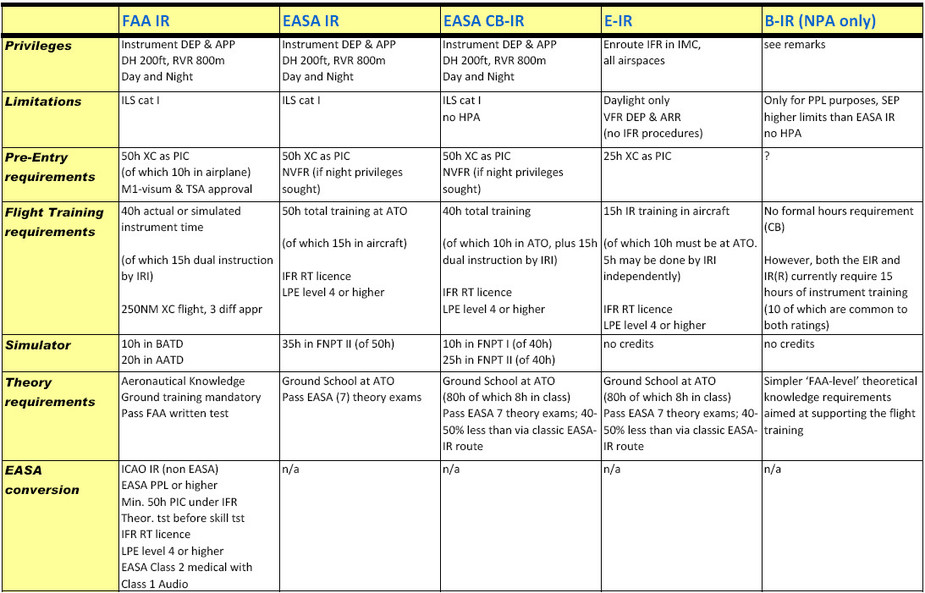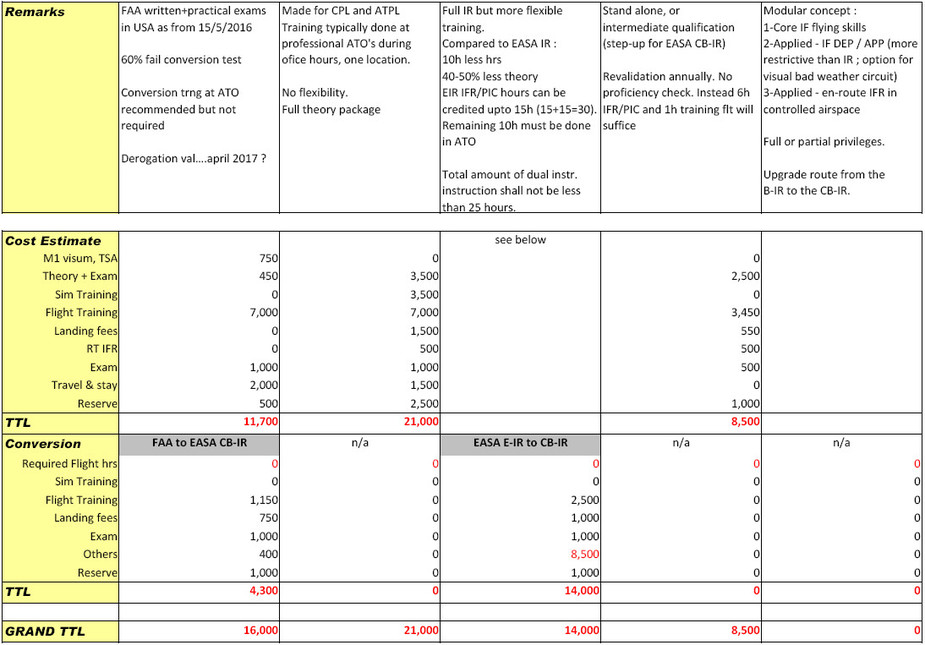Dear flying friends,
Since some time I am considering my options to do my instrument rating – either in the USA or in Europe.
To have a better overall picture, I have put some information together in a comparison sheet :


I feel the most interesting area is the upper part (privileges…remarks).
The lower part (cost estimate) is only for my own reference, based on standard training using C172/PA28. However, most important elements mentioned enabling you to make your own calculations. Costs may vary per location / number of flight hours you can take along, type of aircraft used etc.
For the EIR route (CB) I only took into account the training you need to do via an ATO. Once EIR licenced you may log IFR time as PIC which you can do at your own pace and at reduced costs (no FI or ATO required).
Although I would have liked to start working towards my FAA IR training I have to reconsider because things are changing. Biggest risk is that I would not be allowed to use my FAA IR privileges in Europe as from next year. Also doing EASA conversion is not without risk and adds to the costs.
It looks like taking the EIR route, getting some experience yourself and then doing step 2 (CB-IR) makes more and more sense.
Wishing you lots of wisdom making the proper choices. Would be interested to learn other and/or additional views as well.
One thing is clear: for people staying in Europe, the option is not between getting the FAA IR and getting the EASA IR.
The option is between
a) getting the FAA IR and then getting also the EASA IR in addition
and
b) going straight for the EASA IR.
“Converting” the FAA IR to an EASA is not really a huge deal anymore.
Still, I would tend to agree; I you don’t give a damn about the experience of flying in the US (widening your horizon about general aviation) and you just want an IR for flying in Europe, and don’t intend to fly N-regs(*), and don’t mind studying all kinds of useless theory stuff, then do it here. Which way exactly you do it might depend one several factors, such as if you have your own aircraft (marginal costs only…) available for training and for gaining IFR PIC time afterwards.
( * ) As you can see, when considering your training options, you can’t separate this from your intentions regarding future flying habits and future ownership of an aircraft. In other words, it is even much more complex than your table shows.
I did the EASA IR.
I would be unable to tell exactly how much it costed, but:
- theory was around 1500 euros with Mermoz (distance learning)
- With X flight plans (for training), I hardly paid any tax (in France !)
I also found a school (ATO) who offered training on Saturday and Sunday..
We were alone with my instructor, but I spent there, during two months, some of the best weekends in my life !! :-)
I agree with bosco about flying in the US as a way to widen your horizon. I think @Peter did that ?
As for me, at the time, the recent acquisition of an aircraft was the main reason to learn here.
A very good summary – many thanks for posting it.
I didn’t know the EIR was day only!
I agree that since the FAA route is intimately linked to flying N-reg aircraft, whether to do it is going to be linked to your future flying plans. In particular, while N-reg ownership has many advantages (and continues to have them today) it is best suited to people who are either pro-active on maintenance or are fortunate to use a very good and trustworthy maintenance company.
BTW, I didn’t fly much in the USA. I flew there for 2 weeks while doing my FAA IR – out of Chandler KCHD, near Phoenix, Arizona. I know many people who fly there regularly, and @David (the other founder of EuroGA) did his FAA PPL/IR there, on a long trip around the USA with an instructor – a brilliant way to do it because you end up being a really good pilot when you are done. Whereas here in Europe people get the IR and then have to ask on the internet how to plan and fly from A to B…
A full ab initio JAA/EASA IR will easily cost the average customer £20k or more, because most have to stay at a hotel, so you get all sorts of other costs.
The B-IR is going to be interesting… I wonder who is driving it?
This is indeed a very interesting comparison. I did not realise that the E-IR was limited to day only either. I’ll take your word for it. I also find the price comparison interesting, but I do not understand why you expect that the FAA to EASA IR conversion will be that expensive. As bosco mentioned, the conversion as laid out by the provisions of CB-IR is easily done; it is just a skill test and an oral exam, provided you have 50 hrs PIC time under IFR.
In my case I lived 3 years in California. I had been toying with the idea of taking advantage of my stay to add the IR to my FAR 61.75 license and worn out 3 copies of “Jeppesen Instrument Commercial Handbooks” when 9/11 happened and the airspace around major airports across all of the US was closed to VFR traffic for quite a while (after ALL airspace having been closed to ALL traffic for a few days). Since I could not fly VFR out of Oakland, I decided to sign up for an instrument rating at American Flyers at KHWD (Hayward, CA). The reason I chose them was the availability of airplanes and instructors, but I also anticipated that there could one day be a conversion path to a European IR and thought that the paper trail of a Part-141 school could come in handy (I was wrong about that).
Looking at my logbook I see I started my training on Octobre 10th 2001 and completed exactly one month later, on Nov 10th.
I only recently (one year ago) converted my FAA IR to EASA for three reasons. First of all because the CB-IR conversion route became available. Second because of the prospect of the EASA papers for European residents legislation which has been looming for so long. Then because I got a EASA MEP and wanted to add an IR to that. I therefore did the EASA IR/SE skill test. In parallel I got my MEP and then extended my newly acquired EASA IR to ME.
U-Genius wrote:
Biggest risk is that I would not be allowed to use my FAA IR privileges in Europe as from next year.
Nobody knows. That deadline has been postponed so many times… All you need to 50 hrs PIC under IFR and you can convert with no additional training, although you will need to familiarise yourself with European airlaw and procedures.
Biggest risk is that I would not be allowed to use my FAA IR privileges in Europe as from next year
You will always have those, and for an N-reg you will always need them (FAR 61.3 excepted). What EASA has done is bring in a law which seeks to force pilots of affected aircraft to have EASA papers in addition to the State of Registry (FAA) ones.
Excellent work!
Aviathor wrote:
All you need to 50 hrs PIC under IFR and you can convert with no additional training, although you will need to familiarise yourself with European airlaw and procedures.
Bear in mind that at least 10 of those 50 hours must be in EASA land….
That AFAIK is not written in EASA regulations.
Peter wrote:
I didn’t know the EIR was day only
It’s not, will serve you fine at night too. Still, you would need to land and take-off VFR at night. Like me, the topic starter lives in Holland, where NVFR is hardly allowed. So practically it’s a daytime only privilege.